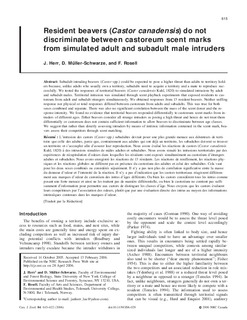| dc.contributor.author | Herr, Jan | |
| dc.contributor.author | Müller-Schwarze, Dietland | |
| dc.contributor.author | Rosell, Frank | |
| dc.date.accessioned | 2008-04-01T13:02:03Z | |
| dc.date.accessioned | 2017-04-19T12:25:17Z | |
| dc.date.available | 2008-04-01T13:02:03Z | |
| dc.date.available | 2017-04-19T12:25:17Z | |
| dc.date.issued | 2006 | |
| dc.identifier.citation | Canadian journal of zoology 84 (2006), No. 4, p. 1227-1237 | |
| dc.identifier.issn | 0008-4301 | |
| dc.identifier.uri | http://hdl.handle.net/11250/2438065 | |
| dc.description.abstract | Subadult intruding beavers (Castor spp.) could be expected to pose a higher threat than adults to territory holders because, unlike adults who usually own a territory, subadults need to acquire a territory and a mate to reproduce successfully. We tested the responses of territorial beavers (Castor canadensis Kuhl, 1820) to simulated intrusions by adult and subadult males. Territorial intrusion was simulated through scent playback experiments that exposed residents to castoreum from adult and subadult strangers simultaneously. We obtained responses from 13 resident beavers. Neither sniffing response nor physical or total responses differed between castoreum from adults and subadults. This was true for both sexes combined and separate. There was also no significant correlation between the mass of the scent donor and the response intensity. We found no evidence that territorial beavers responded differentially to castoreum scent marks from intruders of different ages. Either beavers consider all strange intruders as posing a high threat and hence do not treat them differentially or castoreum does not contain sufficient information to allow beavers to discriminate between age classes. We suggest that rather than directly assessing intruders by means of intrinsic information contained in the scent mark, beavers assess their competitors through scent matching. | |
| dc.language.iso | eng | |
| dc.publisher | National Research Council of Canada | |
| dc.subject | Beavers | |
| dc.subject | Scent marking | |
| dc.subject | Territorial behavior | |
| dc.title | Resident beavers (Castor canadensis) do not discriminate between castoreum scent marks from simulated adult and subadult male intruders | |
| dc.type | Journal article | |
| dc.type | Peer reviewed | |
| dc.subject.nsi | 485 | |
| dc.identifier.doi | http://dx.doi.org/10.1139/Z06-029 | |
